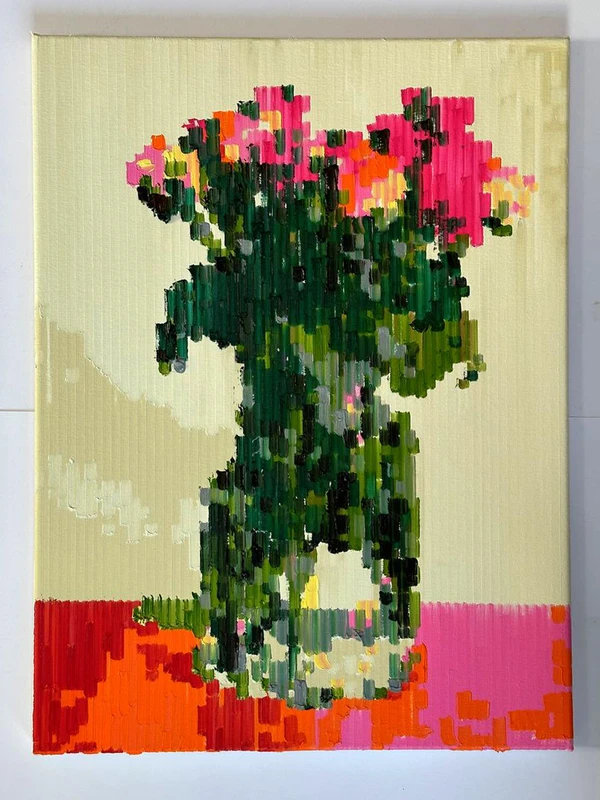Andee Collard's More News About Flowers
7 Jun-6 Jul 2024
PV 7 Jun 2024


Paradise Works and Division of Labour are pleased to present…
Andee Collard’s More News About Flowers.
7th June – 6th July 2024 / East Philip St, Salford, M37LE
More News About Flowers features the work of Andee Collard, Gwen Evans, Hilary Jack, Sian Macfarlane, Ruth Murray and Hannah Wooll, depictions of flowers in painting, ceramics and collage, filmmaking and bronze.
Andee Collard’s new series of twenty floral still-life machine paintings (2022-2024) and three portraits of Walter Benjamin make up the largest part of the exhibition, each painting is created using digital code and an automated machine assembled and modified by the artist.
Covenant (2024) Oil on canvas by Gwen Evans shows an outstretched hand, painted in a deathly green parlour, pinch-holding a small thornless rose. Evans works draws the viewer in, as if entering into an agreement, privy to an exchange of some pact disguised as a gift or love-token. Evans’ work is inspired by the earliest paintings from the Italian Renaissance and where, throughout history, botanical references served as symbols of love and passion but also truth or virtue. This painting wrestles with this duality and invites us to view the work as being simultaneously enchanted by the painting’s ‘objectness’ (it’s aura) and the painting’s odd subject matter (the uncanny) This work has been generously loaned to us by a private collector.
Host (2017) by Hilary Jack was commissioned by Castlefield Gallery and Spinningfields. A series of five bronze cast wild plants dotted around Manchester near Spinningfields and at the Manchester Art Gallery. The accompanying film by Stephen Illes takes us around the sites, hidden and in plain sight, the work plays on the idea of private and public space. The method is lost-wax casting 1:1, a sacrifice of nature, first encased in plaster and then lost, replaced by hot metal.
Sian Macfarlane’s film ‘We will meet sooner than two mountains’ 00:11:34:00 is concerned with the experiences of Victorian artist Lily Whaite in the Welsh landscape, re-locating her archival materials, in an encounter between two artists across time. ‘In a letter from Lily to her father dated December 14, 1903, sent from West Didsbury in Manchester, she speaks of attending a political meeting and in the same paragraph talks of flower arrangements, floral femininity, and political engagement, representative of a time when attitudes regarding women’s position in public life were changing dramatically’1 Working as an artist at the time of Women’s Suffrage, ‘the use of flowers became a recurring motif, Lily’s archive reflecting this Victorian fascination with flowers and their meanings. In her possession was a book titled The Language of Flowers, which contained verse concerning flowers and their meanings, becoming the voice-over in the film We Will Meet Sooner Than Two Mountains:
I wish I were the lily’s leaf
To fade upon that bosom warm,
Content to wither pale and brief,
The trophy of thy fairer form
And I the lily be, and thine the rose
And I the lily be, and thine the rose
An amalgam of “The Lily and the Rose” and “The Wish” by Moore.’2
Ruth Murray’s paintings of flowers carry in them the artists’ devotion to luminosity; Arrangements in Blue (2024) and The Last Time I saw Richard (2024) both demonstrate Murray’s virtuosity in the study and effect of light and distance upon the ‘aura’ of the painting. These works have a quiet beauty in mourning or isolation, and a kind of languorous, contemplative aspect loaded with psychological content. They are also studies for Murray’s usual depictions of women alone in nature.
Untitled (2023) by Hannah Wooll is a low relief glazed ceramic and Untilted (2022) work on paper, depicts Wool’s characteristic figures and portraits of women in nature surrounded by flowers. Her research and working materials take thrifted magazines and old botanical book cuttings to be collaged and mixed with inks, acrylic and oil. The collages have time and distance contained within them, they are dated by the quality of yellowed print, and it’s 1960/70’s chroma. They use scale to create Lilliputian-like scenarios, another reminder of the divide between being human and our unique capability to reproduce nature mechanically. Wooll writes about her work; “I’m Inspired by Technicolor film sets, or starkly lit deliberately contrived and manufactured environments which are oddly dreamlike and static” and in choosing her collage material: “[it] suggests a semi redundant 1970’s style of homemaking and taste, addressing outdated feminine pursuits and domestic crafts.”
The title of the show comes from conversations with Andee Collard and ‘News About Flowers,’ a chapter essay by Walter Benjamin. The essay examines the new and unimaginably modern macrophotographs of flora and fauna from Karl Blossfeldt's (1865–1932) seminal work Urformen der Kunst (Archetypes of Art) (1928). Blossfeldt was a novice to photography and like Collard, Blossfeldt crafted his own ‘machines’, he built his own camera and lenses, allowing him to magnify his subjects many times their natural size, resulting in a strikingly avant-garde, alien-like aesthetic. Benjamin, in bringing us this news of the latest art reproduced by mechanics, chemicals and light, asks, where will the future lead? He turns to Lazio Moholy-Nagy for the last word;
“Everything is so new here that even the search leads to creative results. Technology is, of course, the pathbreaker here.”